The thirst mechanism is located in the:
Adrenal gland
Cerebral cortex
Pituitary gland
Hypothalamus
The Correct Answer is D
Choice A reason: This is incorrect because the adrenal gland is not involved in the thirst mechanism. The adrenal gland is responsible for producing hormones such as cortisol, aldosterone, and adrenaline, which regulate stress response, blood pressure, and metabolism.
Choice B reason: This is incorrect because the cerebral cortex is not involved in the thirst mechanism. The cerebral cortex is the outer layer of the brain that is responsible for higher cognitive functions such as memory, language, and reasoning.
Choice C reason: This is incorrect because the pituitary gland is not directly involved in the thirst mechanism. The pituitary gland is a small gland at the base of the brain that produces hormones that control growth, reproduction, and metabolism. However, the pituitary gland does secrete antidiuretic hormone (ADH), which is regulated by the hypothalamus and affects water balance in the body.
Choice D reason: This is correct because the hypothalamus is the location of the thirst mechanism. The hypothalamus is a part of the brain that regulates many bodily functions such as temperature, appetite, sleep, and emotions. The hypothalamus also monitors the blood osmolarity and triggers the sensation of thirst when the blood is too concentrated.

Nursing Test Bank
Naxlex Comprehensive Predictor Exams
Related Questions
Correct Answer is D
Explanation
Choice A reason: This is incorrect because amino acids are electrolytes. Electrolytes are substances that dissociate into ions when dissolved in water and conduct electricity. Amino acids have both positive and negative charges and can form ions in solution.
Choice B reason: This is incorrect because magnesium is an electrolyte. Magnesium is a metal that forms positive ions (cations) when dissolved in water. Magnesium is important for muscle and nerve function, as well as bone health.
Choice C reason: This is incorrect because phosphates are electrolytes. Phosphates are compounds that contain the phosphate ion (PO4 3-), which is a negative ion (anion) in solution. Phosphates are involved in energy metabolism, acid-base balance, and bone formation.
Choice D reason: This is correct because glucose is a nonelectrolyte. Nonelectrolytes are substances that do not dissociate into ions when dissolved in water and do not conduct electricity. Glucose is a simple sugar that dissolves as a whole molecule in water. Glucose is the main source of energy for the body.
Correct Answer is D
Explanation
Choice A reason: This is incorrect because metabolic alkalosis is characterized by a high pH and a high HCO3-. The patient's pH and HCO3- are both low, indicating acidosis, not alkalosis.
Choice B reason: This is incorrect because respiratory alkalosis is characterized by a high pH and a low PaCO2. The patient's pH is low and PaCO2 is normal, indicating a metabolic problem, not a respiratory one.
Choice C reason: This is incorrect because respiratory acidosis is characterized by a low pH and a high PaCO2. The patient's pH is low, but PaCO2 is normal, indicating a metabolic problem, not a respiratory one.
Choice D reason: This is correct because metabolic acidosis is characterized by a low pH and a low HCO3-. The patient's pH and HCO3- are both low, indicating a metabolic disorder. The condition is uncompensated because the PaCO2 is normal, meaning the respiratory system is not compensating for the metabolic acidosis.
Whether you are a student looking to ace your exams or a practicing nurse seeking to enhance your expertise , our nursing education contents will empower you with the confidence and competence to make a difference in the lives of patients and become a respected leader in the healthcare field.
Visit Naxlex, invest in your future and unlock endless possibilities with our unparalleled nursing education contents today
Report Wrong Answer on the Current Question
Do you disagree with the answer? If yes, what is your expected answer? Explain.
Kindly be descriptive with the issue you are facing.
